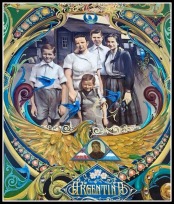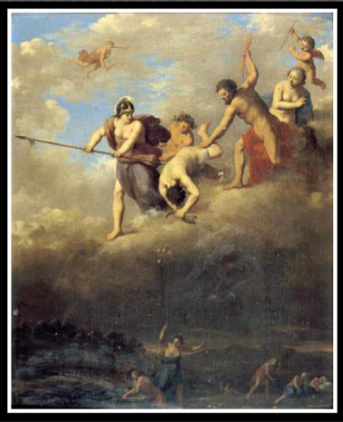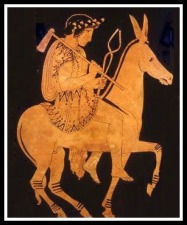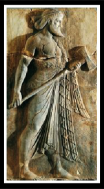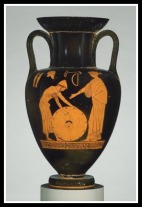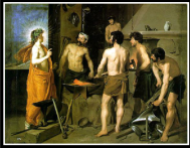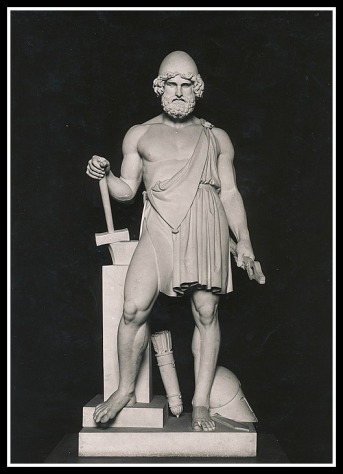► “Athena, Goddess of Knowledge” /
“Athena, Art Gown by Resa McConaghy”🦉:


Athena. Art Gown by Resa McConaghy©2018.

__________________________________________________________________________________________________________________________________________________
This is another post on the series of Tarot, featuring Resa McConaghy´s excellent gown “Athena”.
To recapitulate: in previous posts, I have digged into Tarot: Major and Minor Arcana. Furthermore, in the last post, also written in collaboration with Resa, we´ve analyzed how certain Tarot cards somehow define “archetypes”, and could, therefore, be related to The Hero´s Journey and Mythology.
In this new post, I´ll present Resa´s majestic gown “Athena”.
Before that, I ´ll introduce some facts and information concerning Athena, the Greek Goddess of Wisdom.
Then comes Resa´s gown. By then, we´ll see how some symbolic details she has chosen could be associated with Mythology, Tarot and Astrology.
Finally, aside from Athena and to conclude, I wanted to spotlight some sketches that Resa did, based on Goddess Mnemosyne and Artemis.
______________________________________________________________________________________________
►About Resa McConaghy:
 Resa is a Canadian artist, costume designer and author.
Resa is a Canadian artist, costume designer and author.
She hosts two blogs: Graffiti Lux and Murals and Art Gowns.
You can find her version of this post here. Furthermore, Resa has written a book, “Nine Black Lives”, available on Amazon. Find Resa on Twitter, too!.
(Disclaimer: All gown and sketches photographs were taken by Resa and/or featured on her blog Art Gowns © Resa McConaghy. 2018).
______________________________________________________________________________________________
I. Greek Goddess Athena:

Athens – Pallas Athena Statue at Athens University.
Athena (Roman equivalent: Minerva) was born from Zeus after he experienced an awful headache and she sprang fully grown and in armour from his forehead. She has no mother but one of the most commonly cited stories is that Zeus lay with Metis, the goddess of crafty thought and wisdom, and then swallowed her whole as he feared she will give birth to a child more powerful than him because of a prophecy… But Metis had already conceived.
Athena was the Goddess of Wisdom and knowledge. Besides, she was the Goddess of War, the female counterpart of Ares. Athena’s moral and military superiority to Ares derived in part from the fact that she represented the intellectual and civilized side of war and the virtues of justice and skill, whereas Ares represented mere blood lust.
Athena symbolizes the feminine content that is oriented toward the masculine and particularly helpful to it. Taken as an inner principle, an aspect of a man’s psyche, she represents the feminine figure of wisdom, “Sophia“.
In fact, Athena gravitates toward men in power to learn from them, adopting them as mentors and partners on her own climb to success. She will go so far as to defend them against accusations of misogyny.
Athena didn’t even often acknowledge the existence of her mother, Metis, as she was born from Zeus´ head.
As for defending men, that’s basically what happened in the myth of Arachne.
Arachne challenged Athena to a weaving contest, then she wove a brilliant tapestry that happened to depict Zeus as a promiscuous adulterer.
Athena turned Arachne into a spider.
Interestingly, she didn’t punish Arachne for challenging her to the contest, or for doing a great job. She punished Arachne for having depicted Zeus, Athena’s beloved, respected father, in a bad light.
In the same direction, Jean Bolen feels Athena is very much a supporter of the social/political status quo, as evidenced by her vote to acquit Orestes in the murder of his mother Clytemnestra.
Known for protecting civilized life, Athena was the Goddess of the City of Athens. Her most important festival was the Panathenaea, which was celebrated annually at Athens.
She helped Perseus slay the Gorgon Medusa. Athena assisted Jason and the Argonauts build their ship before they set out to capture the golden fleece. She looked after Achilles during the Trojan War, and later aided Odysseus on his journey home.
Athena was also a patron of the arts and crafts, especially when it came to spinning and weaving. In fact, there is a myth tells that she turned the weaver Arachne into a spider after the mortal woman insulted Athena and the Olympian gods.
Athena was essentially urban and civilized, the antithesis in many respects of Artemis, goddess of wild animals, the hunt, and vegetation.
She was usually portrayed wearing body armour and a helmet and carrying a shield and a lance.
Besides, she was said to be the creator of the olive tree, the greatest blessing of Attica. She was associated with birds, particularly the owl, which became famous as the city’s own symbol, and with the snake.
Jean Bolen groups Athena among the “Virgin Goddesses,” along with Artemis and Hestia.
She was also part of the Judgement of Paris, in which she competed with Hera and Aphrodite for the prize of the Golden Apple.


Athena Statue in Front of the Parliament Building, Vienna, Austria

Detail: Athena Statue in Front of the Parliament Building, Vienna, Austria


Bust of the “Velletri Pallas” type, copy after a votive statue of Kresilas in Athens (c. 425 BC).
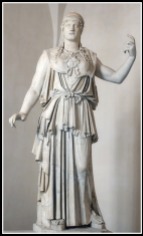
Marble Greek copy signed “Antiokhos”, a 1st-century BC variant of Phidias’ 5th-century Athena Promachos that stood on the Acropolis.

Bronze statue of the goddess Athena known as “Athena of Piraeus” – Classical period, 4th century B.C.

Mattei Athena at Louvre. Roman copy from the 1st century BC/AD after a Greek original of the 4th century BC, attributed to Cephisodotos or Euphranor.

The Athena Giustiniani, a Roman copy of a Greek statue of Athena. Vatican museum.

______________________________________________________________________________________________

II. a) Athena, Gown by Resa McConaghy:



This gown is absolutely beautiful!. Athena, as a Graffiti Goddess is, in my opinion one of Resa´s most original and creative gown.
Resa included many symbols from Tarot, Astrology and Mythology, which she painted on the fabric.
As the paint had made the satin heavier and altered the drape, she added a petticoat.
She included a blue spandex bodice and basted pleats into a strip of the satin. She picked out the basting and draped her “armor” over the spandex… And voilà: Such a Masterpiece!… 🌟💫


II. b) Athena, Gown by Resa McConaghy:
Details and Symbolism:
Many emblematic figures are included in this gown. These symbols, coming from Mythology, Astrology and Tarot are also closely related to Athena. Let´s take a closer look at them…

I. Leo♌:
Resa is Leo!. The zodiac sign Leo is indicatese a Lion. While its glyph appears as the head and tail of a Lion, it also represents the Greek letter “lambda,” which is the first letter in the word “Leon,” meaning Lion.
Leo´s element is fire. The respective date range: July 23 – August 22.
The Tarot card for Leo in Major Arcana is Strength (VIII). This card in the upright position means strength and power. Refusing to get angry, maintaining composure. Caring about others, compassion. Forgiveness. Persuasion, being able to influence.

Leo Symbol.

Major Arcana. VIII: Strength.
•~~~•~~~ •~~~•~~~•~~~•~~~•
II: Libra♎:
Libra was included because is a sign related to Justice, and hence to Athena, as a Goddess of wise counsel and civilization. The sign Libra is represented by the Scales.
They represent the idea of balance and imbalance, and Libra is on a lifelong quest for perfect balance and moderation.
Venus, the planet of love, casts her sensual powers of persuasion and charm on Libra.
The zodiac sign Libra gets its firm mind and morals from the element of Air. Air is the element of intellect and clarity, and Libra leans on these strengths on her quest toward justice and equilibrium. The respective date range for Libra is: September 23 – October 22.
The Tarot card for Libra in Major Arcana is Justice (XI). This card, in the upright position means: Fairness, justice. Honesty and responsibility. Acknowledging the truth and accepting the consequences of your actions.
•~~~•~~~ •~~~•~~~•~~~•~~~•

Libra Symbol.

Major Arcana. XI. Justice.
III. Scorpio♏:
I am Scorpio. The zodiac sign Scorpio equals the Scorpion, and its glyph depicts the sharp stinger of the Scorpion in its pointed arrow. Much like Scorpio, the Scorpion’s natural weaponry allows it to survive and thrive alone in dark or uncomfortable situations.
The planet Pluto harnesses its powerful and persuasive side as it rules over the zodiac sign Scorpio. The element of Water flows consistently and powerfully through the zodiac sign Scorpio. The date range for Scorpio is: October 23 – November 21.
The Major Arcana card for Scorpio is the Death card (XIII ) This card emphasizes the sign’s connection to the transformative cycle of life. This Tarot card uses death in a figurative sense, representing endings of all forms. Scorpio utilizes this concept of impermanence to continually grow, often killing off the ventures, activities, or relationships in its life that no longer serve them to make room for something new.

Scorpio Symbol.

Major Arcana: XIII: Death.
•~~~•~~~ •~~~•~~~•~~~•~~~•
IV. Pisces♓:
The symbol for the sign of Pisces reminds us of two scales and balance, features linked with Athena.
The zodiac sign Pisces is embodied by two Fishes, and its glyph represents an image of these Fishes, linked together. They are a representation of Pisces’ ability to exist simultaneously in both a conscious and subconscious world.
Neptune rules over the zodiac sign Pisces. The element of Water flows through Pisces as a wave of devoted empathy and intuition.
The date range for Pisces is: February 19 – March 20.
The Major Arcana card for Pisces is the Moon (XVIII). This card, in the upright position suggests illusion, fear, anxiety. It may entail deception and losing direction.

Pisces Symbol.

Major Arcana XVIII: The Moon.
•~~~•~~~ •~~~•~~~•~~~•~~~•
V. Venus/Woman Symbol♀:
Athena as a virgin, warrior Goddess is one of the most powerful Greek Goddesses. That´s why Resa chose this symbol, associated with Femininity with Goddess Venus/Aphrodite. Venus was the Roman equivalent of Aphrodite, the Goddess of Love. The symbol is often considered to represent a bronze mirror with a handle or a distaff.

Woman Symbol.

Woman Symbol.
•~~~•~~~ •~~~•~~~•~~~•~~~•
VI. Infinity♾:
Eight (8) is the Number of the perfection, the infinity. In mathematics the symbol of the infinity is represented by a 8 laid down. It presumably evolved from the Etruscan numeral for 1000, which looked like this: CIƆ. There is another theory that he actually derived the infinity symbol from omega (ω), the last letter of the Greek alphabet.
The ouroboros symbol, showing a snake twisted into a horizontal figure eight (8) and biting its own tail, is also said to be a most plausible basis for the infinity symbol because it is a fitting depiction of endlessness. Worth noting that the snake was one of the mos important symbols associated with Athena. The snake’s well-known ability to shed its skin and emerge, apparently reborn, gave rise to an association with rebirth, hence with Athena.

Infinity Symbol.

Infinity Symbol.
•~~~•~~~ •~~~•~~~•~~~•~~~•
VII. Star🌟:
The Star Symbolizes: Inspiration, Imagination, Wonder, Dreams, Pursuits, Magic (, Creative Brilliance, and Divine Guidance. These traits are characteristic of Goddess Athena. In Major Arcana, card XVII is precisely The Star. This card is related to the astrological sign of Aquarius. It entails illumination, guidance and renewal and suggests nourishment and hope.

Stars Detail.

Major Arcana. XVII: The Star
•~~~•~~~ •~~~•~~~•~~~•~~~•
VIII. Queen of Wands and Queen of Swords 👑 🥖 & 👑⚔:
These two Queens could be linked to Athena, as far as determination, strength, rationality and independence are concerned.
⇒Queens of Wands: This card in the upright position means: Exuberance, warmth, vibrancy, determination. Description of the card: The Queen sits upon her throne that is decorated with lions facing opposing direction, a symbol of fire and strength. In her left hand and behind her are sunflowers, symbolising life, fertility, joy and satisfaction. In her right hand is a wand which is beginning to blossom with life. In these positive aspects, the Queen of Wands represents fidelity, warmth, and sustenance. However, at her feet is a black cat, a symbol of the darker, lesser known side of this Queen. Black cats are typically associated with magic and occultism.
⇒Queen of Swords: This Minor Arcana card in the upright position means: Quick thinker, organised, perceptive, independent. Description of the card: The Queen of Swords sits high on her throne. In her right hand, she holds a sword pointed to the sky, and her left hand extends as if she has something to offer to others. The sky is clear, representing her clarity of mind as she considers matters of the intellect. The bird above her head symbolises the mind’s ability to soar above daily issues in order to arrive at appropriate solutions.

Queen of Wands and Queen of Swords.

Minor Arcana: Queen of Wands.

Minor Arcana: Queen of Swords.
•~~~•~~~ •~~~•~~~•~~~•~~~•
IX. Nine of Pentacles 9⃣🔱:
In Tarot, this is a card of Victory, that can not go unnoticed if we think of Athena. This Minor Arcana card in the upright position means: Gratitude, luxury, self-sufficiency, culmination.
Description of the card: The Nine of Pentacles shows a woman walking in the midst of a vineyard. A falcon sits calmly on her left hand. Far in the background is a large house, presumably belonging to the woman herself. There is a general sense of peace, satisfaction, and the fulfilment of a creative venture or personal investment as the result of one’s own efforts.

Nine of Pentacles.

Minor Arcana: Nine of Pentacles.
•~~~•~~~ •~~~•~~~•~~~•~~~•
X. Owl🦉:
Athena Held owls as sacred. In Ancient Greece, owls were associated with wisdom, intuition and prophecy. As a spirit animal, the owl guides us to see beyond the veil of deception and illusion; it helps see what’s kept hidden. It is a strong spirit guide for discernment and making decision based solid foundations.

Owl Symbol.
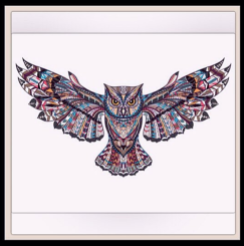
Owl drawing.
•~~~•~~~ •~~~•~~~•~~~•~~~•
XI. Third Eye👁🗨:
The third eye is a mystical and esoteric concept of an invisible eye which provides perception beyond ordinary sigh. The third eye is often associated with religious visions, clairvoyance, the ability to observe auras, premonition, and out-of-body experiences. These traits are clearly related to Goddess Athena.
In ancient Egypt, the all-seeing eye was known as the Eye of Horus or the Eye of Ra. Through various myths they were symbols of protection, healing and restoration.
According to the hindi tradition, The third eye chakra is the sixth chakra, also known as the eye of Shiva. Located on the forehead, between the eyebrows, it is the center of intuition and foresight. The function of the third eye chakra is driven by the principle of openness and imagination.

Third Eye Symbol.

Third Eye Chakra.

Eye of Horus.
_____________________________________________________________________________________________________________________________
III. Sketches by Resa McConaghy:
Mnemosyne and Artemis:
Resa really masters drawing!… Check out these sketches, featured on her blog Art Gowns. Simply stunning!. She used me as a “Muse” to sketch the Goddess Art Gowns we had done posts on. 🤗
My heartfelt thanks to Resa for the sketches. And, above, all for being an inspiration, with her inexhaustible talent, intelligence and versatility. ✨

Mnemosyne Gown.
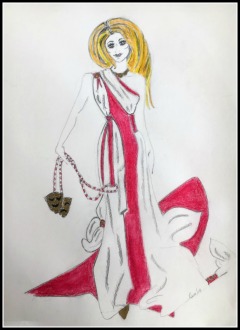
Mnemosyne Sketch.

Artemis Gown.

Artemis Sketch.
______________________________________________________________________________________________
Links Post:
______________________________________________________________________________________________
Read Full Post »
![]()
![]()
 Resa is a Canadian artist, costume designer and author.
Resa is a Canadian artist, costume designer and author. 
![]()
![]()
![]()
![]()
![]()
![]()




























































































 Cerberus watched the
Cerberus watched the 
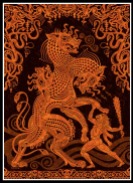







 One of the most moving stories involving dogs in the one concerning Argos, the loyal friend of King
One of the most moving stories involving dogs in the one concerning Argos, the loyal friend of King 








